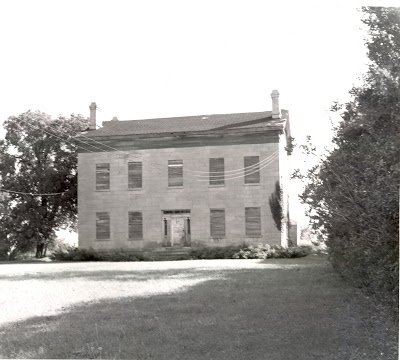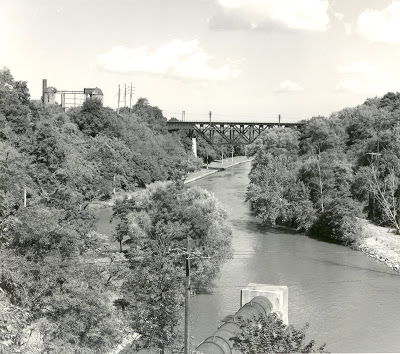The one thing you learn fairly quickly when you’re working with history is the concept of urban legends.

The historical field abounds with them, often to the detriment of the event itself. In an attempt to make local history seem more interesting, embellishments are added. Over time, such additions often become a permanent part of the historical record. As historians, we must wade through these additions in order to arrive at the original story.
That is not to say that the additions to the story are not worthy themselves. As you trace the event back from modern day towards its genesis, each addition has a story of its own. Why was this particular aspect added in the 1960s? Why was this part omitted in the 1890s? And sometimes, the story is lost behind a jumble of supposed truths that hide the very history we’re attempting to research.
Lockport is no stranger to these embellishments. In my decade of working in the Niagara County Historians Office, we have had the same couple of questions asked repeatedly. Top of the list is about the Summit Street Mansion, followed closely by haunted houses and Underground Railroad stops. In all these cases, the same questions are asked over and over again.
The Summit Street mansion has captured the minds of Lockportians for decades. Along with that fascination comes every tall tale imaginable. The house was built 1832-1835 by Joseph S. Pound, although it was more famous for being owned by Francis Hitchins and dubbed “Mount Providence.”

Even today, 150 years after Hitchins sold it, it is known as the Hitchins House. Looking up the Summit Street mansion on Google will give you links that talk about a slave uprising and massacre as well as secret tunnels. These stories persistently hang on despite the fact that neither of these stories have any basis in reality. Examining the first story, there a lot of discrepancies that would make the story impossible.
New York State outlawed slavery with a full emancipation July 4, 1827. There would be no way that the owner of the Summit house would have been able to own slaves, thereby eliminating the very possibility. Lockport was founded by Quakers. As part of their religious beliefs, they were vehemently against slavery, and, in fact, were leaders in the Abolition movement. To claim that Lockport was a hotbed of slavery would be an outright fabrication, just like the story of a slave uprising and massacre.
The second part of the legend surrounding the Hitchins house is much harder to disprove solely on the basis of so many people claiming to have used the aforesaid tunnel. The tale is that when the house was built, there was also a tunnel dug from the basement of the house to the Erie Canal, a short distance away. The narrative continues that the tunnel was used during the time of the Underground Railroad to ferry slaves coming up the canal to a safe place to rest. Considering the abolitionist nature of the area, this part of the story does not seem too far-fetched. However, logistics get in the way.
It would be a major feat of engineering to actually blast a tunnel through this stone nearly 500 feet without damaging the house. It is assumed that the tunnel, if it were part of the original construction, would make it into the articles that followed the progress of building. A likelier construction would date to the time of the enlargement of the canal, nearly a decade after the house was completed. The Hitchins house stands on a small rise just above the edge of the Deep Cut. Built directly on a cap of Lockport Dolomite, the basement floor is solid stone. Again, a project of this magnitude is missing from the record. Even if it were secret, the newspapers of the time would definitely note such a spectacle. In addition, there is no outlet area in the wall of the Deep Cut to indicate a closed off tunnel.
In interviews with the previous owner, Raymond Ruhlmann, I was assured that there were no tunnels leading from the house. I was given several tours in the early 1990s by Ray and he showed me the entire house. According to him, there were never any tunnels. He had spent some time searching the property for where they were believed to be located, but found nothing. Shortly after his death, his son, Raymond, also confirmed to me that there were no tunnels to the canal.
A third, if lesser known legend about the Hitchins House is that the reason scaffolding was left in place on the east side of the house was due to a haunting. The story goes that workmen were getting ready to do some renovations on the house. As they finished erecting the scaffolding and began their work, they were interrupted by several ghosts who interfered with the work to be done. Greatly frightened, the workers left, refused to finish the job, and left behind their scaffolding. During one of the interviews with Mr. Ruhlmann, he assured me that he put up the scaffolding himself and then was “just too damn lazy” to take it down.

Moving on from the great stone house on the outskirts of the city, we move to one of the defining pieces of architecture in downtown Lockport. Known for most of the last forty years as the “Upside Down Railroad Bridge,” the Green Street Trestle has some unique legends of its own. The New York Central & Hudson River Railroad had the bridge constructed in 1902 to replace an earlier structure.
Again, rumors abound with regard to its construction.
First, we’ll get the factual details out of the way. The main span is classified as a Baltimore Deck Truss. According to engineers, this bridge was constructed in this way because its design allowed for larger trains to pass over without risking damage or derailment. In valley crossings, which is what we have here where the railroad crosses the Erie Canal, the height is sufficient enough to not have to worry about flood damage to the structure. This style of bridge is one that is best suited for the environment of its surroundings.
Probably the most enduring legend is the idea that the bridge was built this way in order to restrict travel on the Erie Canal. At 48 feet of clearance, the railroad bridge actually has the highest clearance of any bridge on the canal. In fact, it’s four feet higher than the Pine Street Bridge. The lift bridges have just under 17 feet of clearance. Meanwhile the old bridges that were replaced by the lift bridges (the bridges that were in existence at the time of the construction of the railroad bridge) boasted a clearance of 25-28 feet. Obviously, this all but destroys the idea the bridge was built to restrict canal traffic.
Another legend concerning the bridge is that it was built “upside-down” in order to keep aspiring pilots from dare deviling under the structure with their planes. Again, this myth just doesn’t wash. Orville and Wilbur Wright made the first controlled, powered and sustained human flight on December 17, 1903.
Since the bridge was built before that, it is doubtful that engineers were so forward thinking as to prepare specifications to limit the actions of airplanes.
Having gone through all the Lockport newspapers for the 20th century and all the Common Council minutes for the same era, the railroad bridge was never referred to in the public record as “upside-down” until the 1970s. Before that time, it was referred to as the “Green Street Trestle.” Looking at a map of the city of Lockport as well as driving east one Green Street, it is fairly easy to discern how it got its name. It is clearly an extension of Green Street. In fact, the official name of the bridge is New York Central & Hudson River Railroad Green Street Trestle. Sometime in the 1970s, a decision was made from a tourism standpoint to adopt the moniker, “Lockport’s Upside-Down Railroad Bridge.”
After dispelling the myths surrounding just a couple of the stories floating around the City of Lockport, I thought it would be interesting to conclude with a tale that seems like it should be a legend. Instead, it is an actual story of an actual person.
Before 18-Mile Creek was covered by a culvert from East Avenue to the canal, it used to flow over the escarpment where Spring Street is now. In the rapids before the plunge over the ridge, the creek was split into two small channels, forming an island. It was roughly bounded by East Avenue, Chestnut, McCollum and Spring Streets. Known as Castle Rock, it was the home of Biddy Butler, who was considered a witch by the local boys. In a little house on the island, Butler led a simple life, keeping ducks and a small garden.
There’s not a lot known about Ms. Butler. What little research I was able to do uncovered the following: Biddy Butler arrived in the United States on June 16, 1855, aboard the American Union. Born in Kings, Ireland about 1833, she settled in Lockport, where she appears in the census as a servant. A note in our family files explains that she died in the Poorhouse around the turn of the century. A cursory look through the records of the Poorhouse does not show a Biddy Butler being admitted. However, there is a gap in our records 1899-1918. Very likely she was admitted during this time period.
Once the 18-Mile Creek culvert was completed around 1893, Butler was uprooted from Castle Rock, and the island disappeared beneath the march of progress. No further record can be found of her in the census or directories. The mysterious “Witch of Castle Rock” seems like a tale from the Brothers Grimm.
However, she actually walked the streets of Lockport and made her own way in her own style. There are a great number of urban myths not just around Lockport, but nearly every place you can think of. Each community wants to be unique and showcase that difference to the world at large. There’s really nothing wrong with it, but it does make an historian’s job that much more difficult. Oftentimes, the real history is far more entertaining that anything any Hollywood director could ever dream of.
Craig Bacon is the Deputy Historian for Niagara County. You can visit his office at 139 Niagara Street in Lockport, or contact the office at historian@niagaracounty.com.
All WNY is made possible thanks to coffee and sleep deprivation.
We appreciate your readership. We like money, too.

